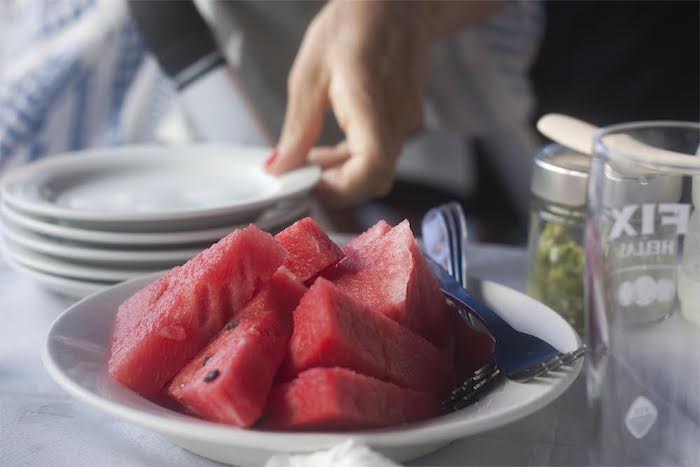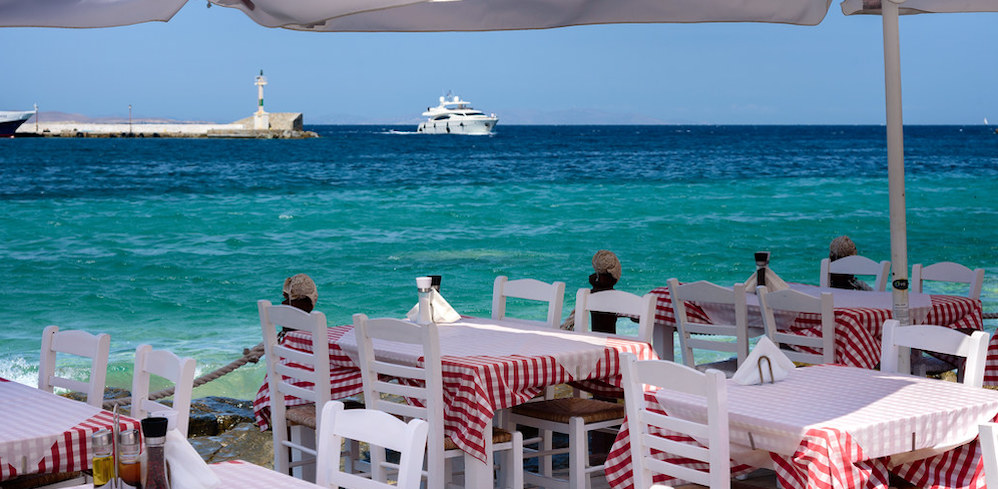“What should I order at a taverna?” might be the question I have been asked most by family and friends and friends of family and friends who come to Greece. Since people usually want to know about the warm season (which is roughly from May to October), I will focus on some of my favorite summer specialties which are served at most Greek tavernas (classic Greek eateries) across the nation.
The Greek taverna meal is all about variety. The focus is often on the appetizers and sharing is usually encouraged for both mains and starters.

Salad and Appetizers
Village bread (Horiatiko psomi)
This crusty bread is simple and delicious and there are lots of variations (with or without olive oil, honey or sesame seeds, for example) but it is delicious most ways and a staple of a conventional Greek mealtime. Even if you are serving 30 starchy dishes, bread is still expected to be on the table, perhaps to mop up the delicious olive oil from the salad or to dip into the tzatziki (yoghurt and cucumber dip) that most people go crazy for.
Yoghurt and cucumber dip (tzatziki)
There are various ways of preparing this staple of every Greek taverna, but my palette prefers the recipes that call for lots of dill and garlic.
Village salad (Horiatiki salata)
Nothing screams Greek summer like the classic combo of cucumbers, onions, tomatoes, green peppers, Greek olives, dried oregano, Greek olive oil and a big piece of feta cheese on top. This is the perfect accompaniment to horiatiko psomi (village bread).
Boiled greens (Horta Vrasta)
Don’t knock ‘em ‘til you try ‘em. Served with lots of olive oil, a pinch of Mediterranean sea salt and a squeeze or three of lemon, many people are pleasantly surprised by the deliciousness of this simple but popular (and super healthy) Greek salad choice.
You might happen upon sorrel, chicory, dandelion, mustard greens or shepherd’s needle … one bite will lead to more.
Pan-fried zucchini (Kolokithakia tiganita)
Not the healthiest starter but possibly the tastiest. You can’t go wrong with a plate of perfectly-battered, freshly-fried and lightly-salted zucchini slices … trust me.
Fava (Yellow split pea puree)
This lemony dip is confusingly named; it is not actually made from fava beans (aka ‘broad beans’), but from yellow split peas! It has a unique and delicious flavor and is usually served with olive oil, onions and capers as toppings.
Main courses
Savory pies (Pites almires)
Somewhere between the appetizers and the main dishes sit the Greek savory pies. The classic ones to try are spinach pie (spanakopita) and cheese pie (tiropita). However, sometimes you will come across a more adventurous pie with fillings such as zucchini (kolokithopita), mushroom (manitaropita), leek (prasopita) or even nettles (tsouknidopita).
Some are made with layers of thin phyllo pastry, whereas others are made with semolina or are completely crustless, relying on just a little flour or an extra egg to hold them together.
Green beans in tomato sauce (Fasolakia Ladera)
One of the main categories of Greek cooking is “Ladera” dishes. This refers to recipes in which veggies are stewed in olive oil, tomato paste and herbs. Ladera dishes are healthy, tasty and suitable for vegans. This one is based on green beans (fresh are the best), onions, potatoes and carrots (some people omit the carrots).
The secret is the addition of a pinch of sugar. Unless you are vegan, be sure to order a side of feta cheese to crumble into this dish and then mop up the sauce with some of that beautiful village bread I mention above.
Veggies never tasted so good!
Classic Greek meatballs (Keftedakia)
Made with pork, beef or lamb or a mixture of these meats, this meatball is made different by a generous addition of mint, parsley, garlic and oregano. The meatballs are covered with flour and fried to perfection. They are typically combined with Greek grandma-style French fries, which usually means medium- or thick-cut potatoes, fried and topped with salt and oregano.

Sweet Treats
Watermelon (Karpouzi)
Don’t be surprised when the server brings you a plateful of sliced watermelon when you ask for the bill. It’s on the house and it’s always refreshing.
Chocolate salami, Greek-style (Mosaiko)
This is a favorite summertime treat made with chocolate, hand-broken cookies, sugar and brandy. Always served cold.
To drink
Water
In recent years, some tavernas and restaurants have taken to bringing a plastic bottle of water to the table (and over-charging for it). If you are in a place where the water is potable, please ask for a carafe of tap water instead.
Not only is plastic bad for the environment but in summer you will often see crates full of plastic water bottles “sunbathing” outside supermarkets or tavernas and therefore more plastic leaching takes place.
(Do note however that the tap water on many islands and on parts of the mainland is sadly not drinkable.)
Wine
The Greek wine served at a taverna is not usually the best or the worst. A good taverna will usually offer a decent house wine for a reasonable price and a few choices for respectable bottled wine.
I am no wine expert, but my favorite wines are almost always from the volcanic islands such as Santorini. And the wine experts agree.
Beer
The Greek beer scene has expanded in recent years. Mamos and Nissos both make a very nice pilsner, both of which go down nicely in warm weather. Vergina and Eza are two well-regarded lagers which are sure to quench your thirst after a day in the Greek sun.
Kali Oreksi! (Good appetite, aka, Bon Appétit)
–––––––––––
Read more about Greece here in Dispatches’ archives.
Read more from Christina here.
A Pittsburgher by birth, Christina T. Hudson is also half Greek and has – so far – spent most of her life in Athens, the chaotic but captivating capital city of Greece.















